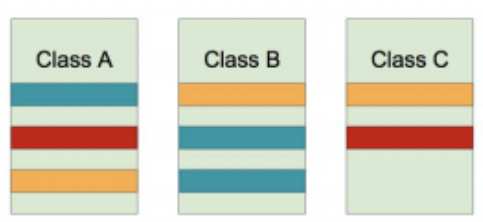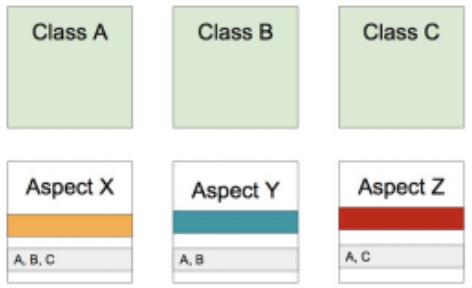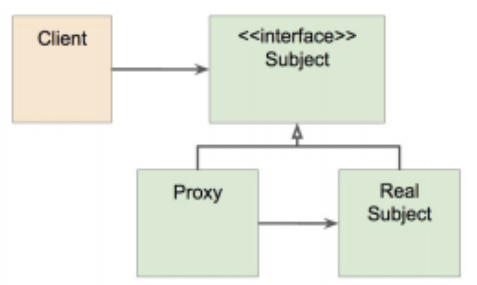1. 개념 소개
Aspect-oriendted Programming (AOP)은 OOP를 보완하는 수단으로, 흩어진 Aspect를 모듈화 할 수 있는 프로그래밍 기법이다.
흩어진 관심사(Crosscutting Concerns)

AOP를 적용하면?

ex) 트랜잭션, 로깅 ...
AOP 주요 개념
- Aspect와 Target
- Advice
- Join point와 Pointcut
Advice는 해아할 일, Pointcut은 어디에 적용해야 하는지 Aspect는 Advice + Pointcut
Target은 위의 그림에서는 Class A, Class B, Class C 이다. JoinPoint는 끼어들 수 있는 모든 지점이다(생성자 호출, 메서드 호출 전, 필드 접근 전 등).
AOP 구현체
- https://en.wikipedia.org/wiki/Aspect-oriented_programming
- 자바
- AspectJ
- 스프링 AOP(AspectJ에 비해 기능과 joinpoint가 국한적임)
AOP 적용 방법
- 컴파일
- 로드 타임
- 런타임(스프링 AOP) : 스프링에서 빈을 만드는 시점은 런타임이다. 따라서 A 클래스의 빈을 만들 때 A라는 타입의 프록시 빈을 만들어 프록시 빈이 AOP를 실행하고 A를 호출한다.
2. 프록시 기반 AOP
스프링 AOP 특징
- 프록시 기반의 AOP 구현체
- 스프링 빈에만 AOP를 적용할 수 있다.
- 모든 AOP 기능을 제공하는 것이 목적이 아니라, 스프링 IoC와 연동하여 엔터프라이즈 애플리케이션에서 가장 흔한 문제에 대한 해결책을 제공하는 것이 목적.
프록시 패턴
- 왜? (기존 코드 변경 없이) 접근 제어 또는 부가 기능 추가

기존 코드
public interface EventService {
void createEvent();
void publishEvent();
void deleteEvent();
}@Service
public class SimpleEventService implements EventService{
@Override
public void createEvent() {
try {
Thread.sleep(1000);
}catch (InterruptedException e){
e.printStackTrace();
}
System.out.println("Created an event");
}
@Override
public void publishEvent() {
try {
Thread.sleep(2000);
}catch (InterruptedException e){
e.printStackTrace();
}
System.out.println("Published an event");
}
public void deleteEvent(){
System.out.println("Delete an event");
}
}@Component
public class AppRunner implements ApplicationRunner {
@Autowired
EventService eventService;
@Override
public void run(ApplicationArguments args) throws Exception {
eventService.createEvent();
eventService.publishEvent();
eventService.deleteEvent();
}
}- 기존 코드를 건드리지 않고 성능을 측정해 보자. (프록시 패턴으로)
@Service
public class SimpleEventService implements EventService{
@Override
public void createEvent() {
long begin = System.currentTimeMillis();
try {
Thread.sleep(1000);
}catch (InterruptedException e){
e.printStackTrace();
}
System.out.println("Created an event");
System.out.println(System.currentTimeMillis() - begin);
}
@Override
public void publishEvent() {
long begin = System.currentTimeMillis();
try {
Thread.sleep(2000);
}catch (InterruptedException e){
e.printStackTrace();
}
System.out.println("Published an event");
System.out.println(System.currentTimeMillis() - begin);
}
public void deleteEvent(){ // 이 메소드에서는 성능 측정 기능을 추가하고 싶지 않다.
System.out.println("Delete an event");
}
}문제는 기존 코드를 건드리지 않고 싶다는 것이다. 따라서 프록시 패턴을 사용한다.
@Primary
@Service
public class ProxySimpleEventService implements EventService{
@Autowired
EventService simpleEventService; // 빈의 이름에 기반해 SimpleEventService를 주입받는다.
//@Autowired
//SimpleEventService simpleEventService;
@Override
public void createEvent() {
long begin = System.currentTimeMillis();
simpleEventService.createEvent();
System.out.println(System.currentTimeMillis() - begin);
}
@Override
public void publishEvent() {
long begin = System.currentTimeMillis();
simpleEventService.publishEvent();
System.out.println(System.currentTimeMillis() - begin);
}
@Override
public void deleteEvent() {
simpleEventService.deleteEvent();
}
}프록시 클래스가 하는 일은 의존성을 주입받은 simpleEventService 인스턴스에게 위임되었으나, 성능은 프록시 클래스에서 측정한다.
참고 : 웹 서버 모드로 실행하지 않는 방법
@SpringBootApplication
public class Springtest11Application {
public static void main(String[] args) {
SpringApplication app = new SpringApplication(Springtest11Application.class);
app.setWebApplicationType(WebApplicationType.NONE);
app.run(args);
//SpringApplication.run(Springtest11Application.class, args);
}
}문제점
- 매번 프록시 클래스를 작성해야 하는가?
- 여러 클래스 여러 메소드에 적용하려면?
- 객체들 관계도 복잡하고...
그래서 등장한 것이 스프링 AOP
- 스프링 IoC 컨테이너가 제공하는 기반 시설과 Dynamic 프록시를 사용하여 여러 복잡한 문제 해결.
- 동적 프록시: 동적으로 프록시 객체 생성하는 방법
- 자바가 제공하는 방법은 인터페이스 기반 프록시 생성.
- CGlib은 클래스 기반 프록시도 지원. - 스프링 IoC: 기존 빈을 대체하는 동적 프록시 빈을 만들어 등록 시켜준다.
- 클라이언트 코드 변경 없음.
- AbstractAutoProxyCreator implements BeanPostProcessor
3. @AOP
애노테이션 기반의 스프링 @AOP
의존성 추가
<dependency>
<groupId>org.springframework.boot</groupId>
<artifactId>spring-boot-starter-aop</artifactId>
</dependency>애스팩트 정의
- @Aspect
- 빈으로 등록해야 하니까 (컴포넌트 스캔을 사용한다면) @Component도 추가.
포인트컷 정의
- @Pointcut(표현식)
- 주요 표현식
- execution
- @annotation
- bean - 포인트컷 조합
- &&, ||, !
어드바이스 정의
- @Before
- @AfterReturning
- @AfterThrowing
- @Around : 메소드 호출 자체를 감싸고 있어서 메소드 호출 전후와 에러처리까지 할 수 있다.
@Component
@Aspect
public class PerfAspect {
//@Around("execution(* com.example..*.EventService.*(..))")
//com.example 패키지에 속한 EventService에 있는 모든 메서드에 적용한다.
//@Around("@annotation(PerfLogging)")
//PerfLogging 애노테이션이 달려있는 메소드에만 적용한다.
@Around("bean(simpleEventService)")
//빈의 모든 메서드에 적용된다.
public Object logPerf(ProceedingJoinPoint pjp) throws Throwable{
long begin = System.currentTimeMillis();
Object retVal = pjp.proceed();
System.out.println(System.currentTimeMillis() - begin);
return retVal;
}
@Before("bean(simpleEventService)")
public void hello(){
System.out.println("Hello");
}
}/**
* 이 애노테이션을 사용하면 성능을 로깅해 줍니다.
*/
@Documented
@Target(ElementType.METHOD)
@Retention(RetentionPolicy.CLASS)
public @interface PerfLogging {
}@Service
public class SimpleEventService implements EventService{
@PerfLogging
@Override
public void createEvent() {
try {
Thread.sleep(1000);
}catch (InterruptedException e){
e.printStackTrace();
}
System.out.println("Created an event");
}
@PerfLogging
@Override
public void publishEvent() {
try {
Thread.sleep(2000);
}catch (InterruptedException e){
e.printStackTrace();
}
System.out.println("Published an event");
}
public void deleteEvent(){
System.out.println("Delete an event");
}
}주의할 점은 애노테이션을 만들 때 Retention 정보를 CLASS(default) 이상으로 줘야 한다. SOURCE가 되면 컴파일 이후에 애노테이션이 사라진다.
참고
- 인프런 : 스프링 프레임워크 핵심 기술(백기선)
- https://en.wikipedia.org/wiki/Aspect-oriented_programming
- https://docs.spring.io/spring/docs/current/spring-framework-reference/core.html#aop pointcuts
